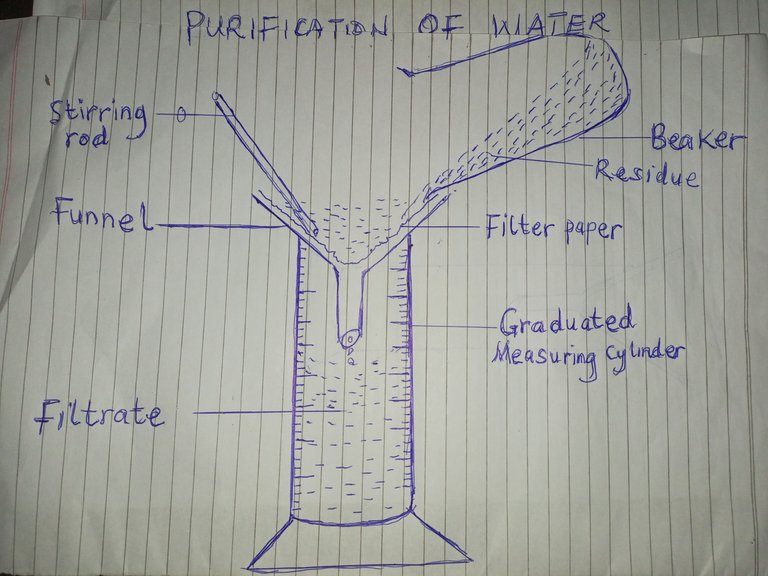Hello Guys!,
I've realized that my Science Students were very interested in the practical lesson taught yesterday. They are progressively being able to demonstrate how our local alcohol popularly know as "Akpeteshie" being prepared from palm. So today, we want to demonstrate "how water from river which contain sediments can be purified for drinking."
"Review of last practical lesson"
Before then, let's quickly recap our practical lesson on simple distillation. We learnt that two miscible liquids such as alcohol and water like "palm wine" with different boiling points can be separated through simple distillation set ups. Through boiling of the palm, the alcohol turns into vapour at 78°c passes through the metal tube. The second station of the coiled pipe condenses or cool it as we learnt in change of state of matter from vapour (gas) to liquid is by cooling. The could alcohol is collected as distillate. After 100°c the water in the palm wine begins to boil, with the help of the thermometer placed at the lid of the barrel help us to detect the exhaustion of the ethanol from the palm wine. Now it's assume that the vapour coming through the pipe at this time is water content.
Introduction
In most of our villages here, the main source of water is river. With this only few places which the landscapes have valleys and mountains are noted to have rivers. Water collect on the surface of the land is noted to being contaminated with some sediments or residues of leaves, dust, tree branches refuse polythene materials and other biochemical products. Due to illiteracy among some of the local people, they ignorantly drink the water from these contaminated rivers without boiling and purifying them. The resultant effects are the infection of cholera disease and other water borne diseases which would be studied in our subsequent lessons.

A well labelled diagram of filtration using pen & sheet of paper. drawing was done by me
How water from river is purified safe for drinking
To some scientist, they would go straight by demonstrating how to purify the water without first boiling. The reason being that they have other alternative like addition of chlorine (chlorination) to kill all the germs which is mostly done during purification of water for large communities. When preparing for individual or small village use, you've to first boil the water in a cleaned container and hygienic environment. The essence of boiling is to kill the germs found in the water. Leave the water to cool for some minutes for beginning the purification.
Apparatus/Things needed to purify water from the river
1• water from river
2• empty cleaned container
3• White cloth
4• Big funnel
5• stirring rod
Procedure/method of purification
After boiling the water fetched from source of river, make sure to set up the apparatus as follows:
- place the funnel at the mouth of the container. If it's a large container with the large open then you've to get the help from your neighbour.
Lay the white cloth on the funnel. At the laboratory demonstration, students are require to use filter paper. Since we are purifying for home consumption is best we use white cloth. Make sure to cover all the circumference of the funnel with the white cloth to avoid splashing of the water into the container.
Gently pour your boiled water into the white cloth white cloth. You can use the stirring rod to stir making sure that the filtrate drain into the container.
- After all the water has drained into the empty container, we would see sediments settling on the white cloth.
We can now keep the filtrate collected in our water storage tank or cooler safe for drinking. This is a simple method of purifying water in our villages. However on commercial basis, the contaminated water has to pass through a lot of processes like introduction of alum and chlorination. To demonstrate to student at laboratory, we use graduated measuring cylinder, filter paper, beaker, funnel, stirring rod and the river water. When students are taught practically how they should carry out filtration at school, they would be able to apply it in their homes in everyday life.
About me:



https://leofinance.io/threads/@jude9/re-leothreads-2xyc2p
The rewards earned on this comment will go directly to the people ( jude9 ) sharing the post on LeoThreads,LikeTu,dBuzz.
I remember doing this practical in secondary school and it was done exactly like this 😊
Chemistry.....
Thanks for loving it. I appreciate your comment.
You're welcome sir 😊
If your students are able to demonstrate applications of what you have tought to them, then indeed your way of teaching is very much effective and they are loving it. You're doing a great job!
Thanks so much @splash-of-angs63 for loving my project. Yes, I love teaching practicals with passion.
Congratulations @jude9! You have completed the following achievement on the Hive blockchain And have been rewarded with New badge(s)
Your next target is to reach 800 upvotes.
You can view your badges on your board and compare yourself to others in the Ranking
If you no longer want to receive notifications, reply to this comment with the word
STOPTo support your work, I also upvoted your post!
Check out our last posts:
Thanks for the update. Remember to back up your posts with solid sources, so the reader can learn more, double check your claims, not take your word for everything, etc. It is a curation standard.
Thanks for the reminder. But most of the things I write is through my own experience. If I make further research I think I will not hesitate to add the links as I have done through my previous posts.
Thanks for your contribution to the STEMsocial community. Feel free to join us on discord to get to know the rest of us!
Please consider delegating to the @stemsocial account (85% of the curation rewards are returned).
You may also include @stemsocial as a beneficiary of the rewards of this post to get a stronger support.
Hello, I congratulate you on the article, there are several methods to purify water: Filtration, Boiling, Chlorine disinfection, iodine disinfection, desalination, although the purification which you mention is quite practical and I have used it at home on some occasions.
Thanks for coming around. Yes, there are so many methods as you rightly mentioned.